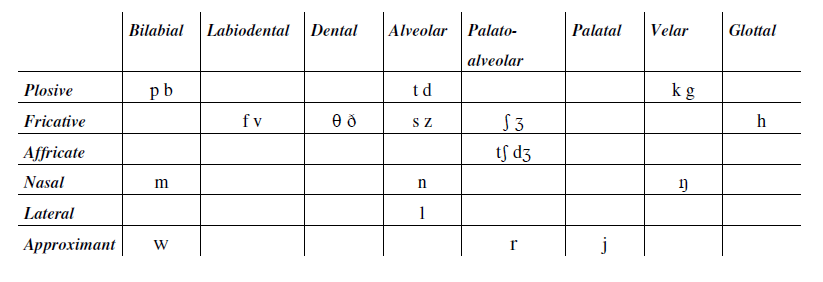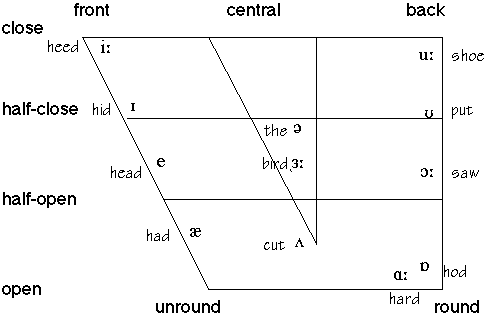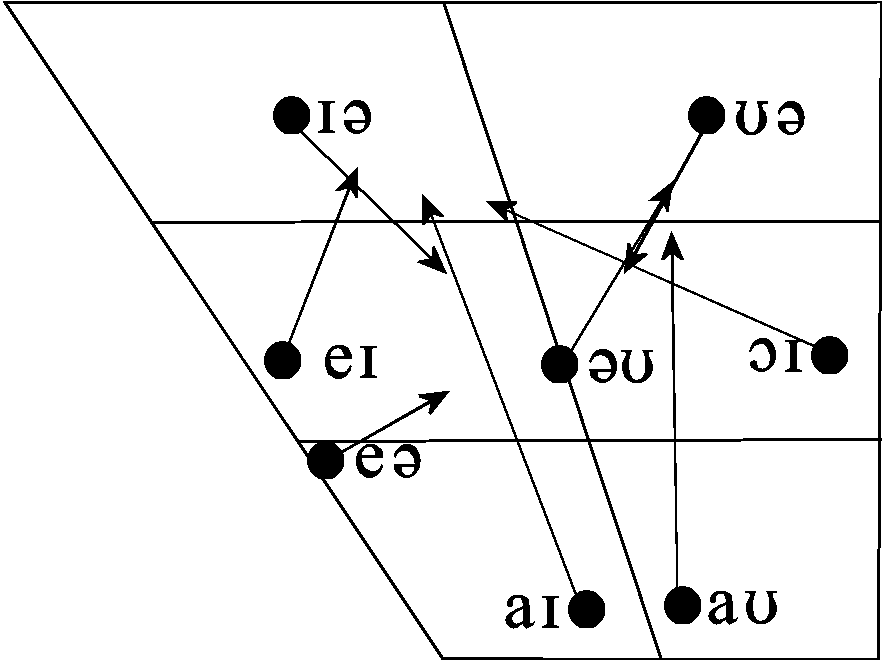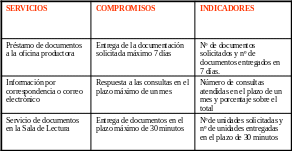PHONETICS AND PHONOLOGY 31 PHONETICS AND PHONOLOGY A) PHONOLOGY
ALLAMA IQBAL OPEN UNIVERSITY PHONETICS & PHONOLOGY INSTRUCTOR MOAZZAMЛЕКЦИЯ № 1 PHONETICS AS A BRANCH OF LINGUISTICS
FACULTY OF LINGUISTICS PHILOLOGY AND PHONETICS LINGUISTIC PROJECT TOPIC
FREE WEB SITES FOR ENGLISH PRONUNCIATION WITH SOUND HTTPWWWUIOWAEDU~ACADTECHPHONETICSENGLISHFRAMESETHTML
INTRODUCTION TO ENGLISH PHONOLOGY AND PHONETICS PD DR NESSELHAUF
PHONETICS AND PHONOLOGY 31 PHONETICS AND PHONOLOGY A) PHONOLOGY
PHONETICS AND PHONOLOGY
3.1 Phonetics and Phonology
a) Phonology is about patterns of sounds, especially different patterns of sounds in different languages, or within each language, different patterns of sounds in different positions in words etc. Phonology is the study of how sounds are organized and used in natural languages
The phonological system of a language include
an inventory of sounds and their features, and
rules which specify how sounds interact with each other.
b) Phonetics deals with the production of speech sounds by humans, often without prior knowledge of the language being spoken.
|
Phonetics |
Phonology |
|
Phonetics is the study of the nature of sound itself |
Phonology is the study of the sound systems of a language. |
|
Phonetics simply describes the articulatory and acoustic properties of phones (speech sounds). |
Phonology studies how sounds interact as a system in a particular language. |
|
Phonetics studies which sounds are present in a language and how these sounds can be represented using the International Phonetic Alphabet |
Phonology studies how these sounds combine and how they change in combination, as well as which sounds can contrast to produce differences in meaning |
|
Phonetics studies how the vocal tract modifies the vibratory sound generated by the glottis to produce recognizable speech sounds in English and other languages.
|
Phonology studies how we can describe all languages’ sounds in terms of smaller components called “distinctive features”.
|
|
Phonetics studies how articulation of individual sounds varies according to dialect and other factors. |
Phonology studies how syllabification affects the actual articulation of sounds and vice versa.
|
|
Phonetics studies how sounds overlap with each other in co articulation. It studies how features such as voicing, vowel height and back ness, lip rounding, place and manner of articulation affect the acoustic pattern of a sound. |
Phonology
studies how we can describe common linguistic changes in terms
how humans might process them in the brain.
|
3.2 Branches of Phonetics
Articulatory phonetics: the study of how speech sounds are made or articulated.
Acoustic phonetics: deals with the physical properties of speech sounds such as sound waves in the air.
Auditory phonetics: deals with the perception of speech sounds via the ear.
3.3 Phoneme, Phone and Allophone
Phoneme is the smallest unit of speech distinguishing one word (or word element) from another (e.g., the sound p in tap, which differentiates that word from tab and tag). Phonemes may be recorded with special symbols, such as those of the International Phonetic Alphabet (IPA). In transcription, linguists conventionally place symbols for phonemes between slash marks: /p/.
A phoneme is a family of similar sounds which a language treats as being "the same". Members of the family are called its allophones.
In English, [p] and [ph] are allophones of the /p/ phoneme.
In phonetics the smallest perceptible segment is phone.
A phone is an unanalyzed sound of a language. It is the smallest identifiable unit found in a stream of speech that is able to be transcribed with an IPA symbol.
A speech sound or gesture considered as a physical event without regard to its place in the phonology of a language.
For example, p as in pin and p as in spin are allophones in the English language. English speakers generally treat these as the same sound, but they are different. The latter is unaspirated: it sounds a little more like the b of English. The preceding s is the usual context for the unaspirated allophone. Chinese treats them differently and the latter is written as b in pinyin; thus, they are not allophones in Chinese.
3.4 Syllable, Vowel and Consonants
Syllable is a phonetic unit larger and more stable than phoneme. Syllable is a unit of spoken language consisting of a single uninterrupted sound formed by a vowel, diphthong, or syllabic consonant alone, or by any of these sounds preceded, followed, or surrounded by one or more consonants. Syllables are often considered the phonological "building blocks" of words.
A syllable consists of an onset and a rhyme, and a rhyme in turn consists of an vowel and final consonant(s).

 Syllable
Syllable
Rhyme

 Onset
Onset
Nucleus Coda
A vowel is a type of sound for which there is no closure at any point of the vocal tract.
A consonant is a sound in spoken language that is characterized by a constriction or closure at one or more points along the vocal tract.
There are three ways of describing the consonant sounds
The manner of articulation
The place of articulation
The force of articulation
3.5 Manners of Articulation
There are six manners of articulation.
|
Manners |
How Produced |
Examples |
|
Stops/Plosives |
By stopping the airflow in the vocal tract and then releasing it explosively. |
[p],[b],[t],[d],[k],[g] |
|
Affricates |
A sound that begins as a stop but releases as a fricative |
[tʃ], [dʒ] |
|
Fricatives |
By forcing air through a narrow channel made by placing two articulator close together |
[f],[x] |
|
Nasals |
When velum is lowered, allowing air to escape freely through nose |
[m],[n] |
|
Lateral |
The airflow is around the sides of the tongue |
[l] |
|
Approximants |
Continuous flow of air through the vocal tract, less friction than a fricative but more than a vowel |
[r],[w],[j] |
3.6 Places of Articulation
|
Where Produced |
Where Produced |
Examples |
|
Bilabial |
Lips together |
[p], [b], [m], [w] |
|
Labio-dental |
Upper teeth on lower lip |
[f], [v] |
|
Dental |
Upper teeth on tip of tongue |
[θ], [ð] |
|
Alveolar |
Tip of tongue on hard ridge behind upper teeth |
[t], [d], [s], [z], [n], [l], [r] |
|
Plato-Alveolar |
Tip of tongue is raised towards the roof of the mouth, between the alveolar ridge and hard palate |
[tʃ], [dʒ], [ʒ], [ʃ] |
|
Palatal |
Front of tongue is raised to hard palate |
[j] |
|
Velar |
Back of tongue is raised to soft palate |
[k], [g], [η] |
|
Glottol |
The vocal cords |
[h] |

3.7 The Force of Articulation
a) Voiced Sounds
Vocal sounds are called voiced if the vocal cords are vibrating.
b) Voiceless Sounds
Vocal sounds are called voiceless if the vocal cords are not vibrating.
c) Fortis/Lenis
The fortis/lenis distinction describes the voicing differences of consonants. The term, ‘fortis’ suggests a greater amount of force employed in the production of consonants. The term, ‘lenis’ suggests a smaller amount of force employed in the production of consonants. In English, all voiceless consonants are produced with greater force than the voiced consonants.
3.8 Vowels: Open, Mid and Close Vowels
A vowel is a type of sound for which there is no closure of the throat or mouth at any point where vocalization occurs.
For close vowel the tongue is quite high in the mouth.
For mid vowels the tongue is neither high nor low in the mouth.
For open vowels, the tongue is low in the mouth.

3.9 Diphthongs
Diphthongs are types of vowels where two vowel sounds are connected in a continuous, gliding motion. They are often referred to as gliding vowels.


/ai/ (kite, fight, night, fried)
/ei/ (say, pay, rate, paper, plate)
/כi/ (boy, soil, coil, boil)
/au/ (shout, flower, couch)
/әu/ (no, soul)
/iә/ (fear, near, mere, career)
/eә/ (fair, gear, flare, prayer)
/uә/ (sure, poor, doer)
3.10 Assimilation
In many languages, sounds belonging to one word can change depending on the environment of its occurrence. When a phoneme is realized / articulated differently due to its context or neighboring sounds, the process is known as assimilation. Assimilation is more likely to be found in rapid, casual speech. In English, assimilation usually affects consonants at word boundaries.
/ t / changes to / p / before / m / / b / or / p / (circuit board, sit back)
/ d / changes to / b / before / m / / b / or / p / (mixed bag, used before)
/ n / changes to / m / before / m / / b / or / p / (van bumper, brown paper)
/ t / changes to / k / before / k / or /g/ (short cut, that cake)
/ d / changes to / g / before / k / or / g / (hard copy, red carpet)
/ n / changes to /ŋ/ before / k / or / g / (open court, town clerk)
/ s / changes to /ʃ/ before /ʃ/ or / j / (bus shelter, nice shoes)
/ z / changes to /ʒ/ before /ʃ/ or / j / (cheese shop, these sheep)
/θ/ changes to / s / before / s / (fifth set, fourth season)
3.11 Elision
Elision is the omission of sounds, syllables or words in speech. This is done to make the language easier to say, and faster.
Elision of sounds can be seen clearly in contracted forms like isn't (is not), I'll (I shall/will), who's (who is/has), they'd (they had, they should, or they would), haven't (have not) and so on. We see from these examples that vowels or/and consonants can be elided.
potato /p ̍teιtǝʊ/
tomato /t ̍mɑ:tǝʊ/
tonight /tͅnaιt/
police /pͅli:s/
3.12 Linking R Sound
In British English, when a word ends in an 'r', we do not pronounce this letter! There is only one exception to this, and that is when the following word begins with a vowel sound, and in this case, we do pronounce it, as it helps us link the two words together.
This pronunciation technique is known as the Linking R.
Father-in law
The hare and the tortoise
Clear as water
3.13 Intrusive R Sounds
In a similar way, we sometimes add an imaginary 'r' sound, even when there isn't an 'r' at the end of the first word. This pronunciation technique is known as the Intrusive R. Again, we do this to speak more fluently and to make one word transition more easily into the next.
The United States of America [r] is a big country.
Donna [r] and her mother.
A banana [r] is a yellow fruit.
Pamela [r] Anderson.
I want to visit China [r] and Vietnam.
PHONETICS AND PHONOLOGY TEST 1 LOOK AT THE UNDERLINED
PHONETICS OF EFL DICTIONARY DEFINITIONS A BOOK IN PRESS
PHONETICS PHONETICS IT STUDIES IN GENERAL WITHOUT ANY REFERENCE
Tags: phonology 3.1, the phonology, phonology, phonetics
- LA BANDA DE MÖBIUS Y EL PLANO PROYECTIVO INTRODUCCIÓN
- FORMULIR PENGGANTIAN DOSEN PEMBIMBING KARYA TULIS ILMIAH SAYA YANG
- SJEKKLISTEFOR VERNERUNDE DETTE ER ET EKSEMPEL PÅ SJEKKLISTE FOR
- INTROSITE DFS LUTTER CONTRE LA « DÉLINQUANCE FINANCIÈRE »
- KYIV ON APRIL 14 2008 KYIV DECLARATION OF THE
- SANTOS 1 SANTO 1 SANTO SANTO SANTO SANTO ES
- Ðïࡱáþÿ ·ºþÿÿÿµ¶¥áw Ø¿]bjbj]é]é r?£ãe?£ãeqq»ÿÿÿÿÿÿ·ssÿÿÿÿccc8{ä?dcô£&£¦i(qqq G(4{(£ £ £ £ £
- AĞIR CEZA MAHKEMESİ SAYIN BAŞKANLIĞI’NA DOSYA
- MODELO DE MEMORIA EXPLICATIVA DEL PROYECTO DE ACTIVIDAD PROFESIONAL
- ČESTNÉ PROHLÁŠENÍ JMÉNO A PŘÍJMENÍ ÚČASTNÍKA DATUM NAROZENÍ TEL
- HOW TO VIEWCHANGE GRADES OR CHECK MARK ENTRY IS
- HANDBOOK FOR LOCAL PASTORS AND ASSOCIATE MEMBERS NORTH CAROLINA
- INTRODUCED BY THE COUNCIL PRESIDENT AT THE REQUEST OF
- el Experto fue Nombrado Nuevo Académico de Número en
- INTRODUCTION TO VECTOR GRAPHICS & ILLUSTRATOR (NOTES) C 28
- 2013 WOMENS TENNIS DUAL TEAM RESULTS STATE CHAMPIONSHIP FULLERTON
- CURRICULUM VITAE PERSONAL INFORMATION FIRST NAME SURNAME GABRIELLA TESTA
- 5 JUAN J GARCÍA PELLICER JOSÉ V GARCÍA JIMÉNEZ
- DEVELOPMENT AS FREEDOM NOTES AND DISCUSSION OUTLINE THE BOOK
- [EXASOL1915] EXAOPERATION ONLY ENABLE BACKUP DOWNLOAD INTERFACES ON DEMAND
- PREINSCRIPCIÓN DATOS DEL CLUB PARTICIPANTE NOMBRE DEL
- SAJTÓINFORMÁCIÓ 3 SEMPERIT SPEEDLIFE 2 – EGY
- INTRODUCCIÓN LOS METADATOS NO SON ALGO NUEVO ANTES DE
- LA NACIENTE COMUNIDAD SUDAMERICANA ENFRENTA ENORMES RETOS HTTPWWWLAHORACOMECNOTICIACOMPLETAASP?NOID304321
- [EXASOL2734] REDUCED EXECUTION TIME FOR DRIVERLIMITED RESULT SETS CREATED
- FORM B APPLICATION FOR AN APPROVAL TO EXHIBIT ANIMALS
- INTRODUÇÃO À ECONOMIA – PARTE I MICROECONOMIA EXERCÍCIOS
- SUSAN MOSE & OLE RAVN DIGTBOGEN RYTMEN OG DIGTETS
- EXTRACT FROM P2122 (END OF ACT 1) (THEY EXIT
- 1PIELIKUMS IEPIRKUMA IDENTIFIKĀCIJAS NRBNA 2014056 PIETEIKUMS PRETENDENTS PRETENDENTA
CLASIFICACIÓN GENERAL POSICIÓN DORSAL TIEMPO PROMEDIO TIEMPO NETO CORREDOR
LOCATED AT THE FOLLOWING WEBSITE HTTPWWWNUORGBOUNDAFLIBROHTM
 BOKBINDERIMATERIAL OCH HOBBY HB 1107 GRÄSHOLMSVÄGEN 12 STRÖMTORP SE
BOKBINDERIMATERIAL OCH HOBBY HB 1107 GRÄSHOLMSVÄGEN 12 STRÖMTORP SEGUÍA DE TELÉFONOS POLICIALES ASUNTOS INTERNOS DIRECTOR CÓRDOBA
FROM REFUND OF EXCESS CONCESSIONAL CONTRIBUTIONS SENT THURSDAY 7
CONGREGATION FOR THE DOCTRINE OF THE FAITH RESPONSES TO
 REGLAMENTO DEL SISTEMA DE BIBLIOTECAS CÓDIGO UNABDGBDIRPI007 FECHA EMISIÓN
REGLAMENTO DEL SISTEMA DE BIBLIOTECAS CÓDIGO UNABDGBDIRPI007 FECHA EMISIÓNDR LAJOŠ FORO RETORZIJA PROTIV VOJVOĐANSKIH MAĐARA 194445 GODINE
ANNEX IV ANEXO IV SOL·LICITUD D’AUTORITZACIÓ DEL PROGRAMA
OFFICIAL SIGNS CHECKLIST WISCONSIN DEPARTMENT OF TRANSPORTATION DT1684 32007
 RESOLUÇÃO Nº 215 DE 14 DE DEZEMBRO DE 2006
RESOLUÇÃO Nº 215 DE 14 DE DEZEMBRO DE 2006 JM VOITH SE & COKG DIVISION TURBO STANDORT CRAILSHEIM
JM VOITH SE & COKG DIVISION TURBO STANDORT CRAILSHEIM SPORTY OLIMPIJSKIE GR I UCZESTNICY IGRZYSK OLIMPIJSKICH – LONDYN
SPORTY OLIMPIJSKIE GR I UCZESTNICY IGRZYSK OLIMPIJSKICH – LONDYNBIANKÓ SZÁM 0105300 SZERVEZETI EGYSÉG NEVE ……………………… NYUGDÍJELŐTAKARÉKOSSÁGI SZÁMLACSOMAG
 HACIA EL ESTABLECIMIENTO DE UNA POLÍTICA DE CALIDAD EN
HACIA EL ESTABLECIMIENTO DE UNA POLÍTICA DE CALIDAD ENDOMESTIC ABUSE INTRODUCTION AND ACKNOWLEDGEMENT IN 2002 THE METHODIST
 BETECKNING ER BETECKNING DOKUMENTTYP SIDA TSV 20095845 3(3) DATUM
BETECKNING ER BETECKNING DOKUMENTTYP SIDA TSV 20095845 3(3) DATUMPUBLIC HEALTH PRIVACY NOTICE PUBLIC HEALTH ENCOMPASSES EVERYTHING FROM
 REPÚBLICA DE COLOMBIA MINISTERIO DE LA PROTECCIÓN SOCIAL INSTITUTO
REPÚBLICA DE COLOMBIA MINISTERIO DE LA PROTECCIÓN SOCIAL INSTITUTOANEXĂ LA HOTĂRÎREA COMISIEI ELECTORALE CENTRALE NR 2791 DIN